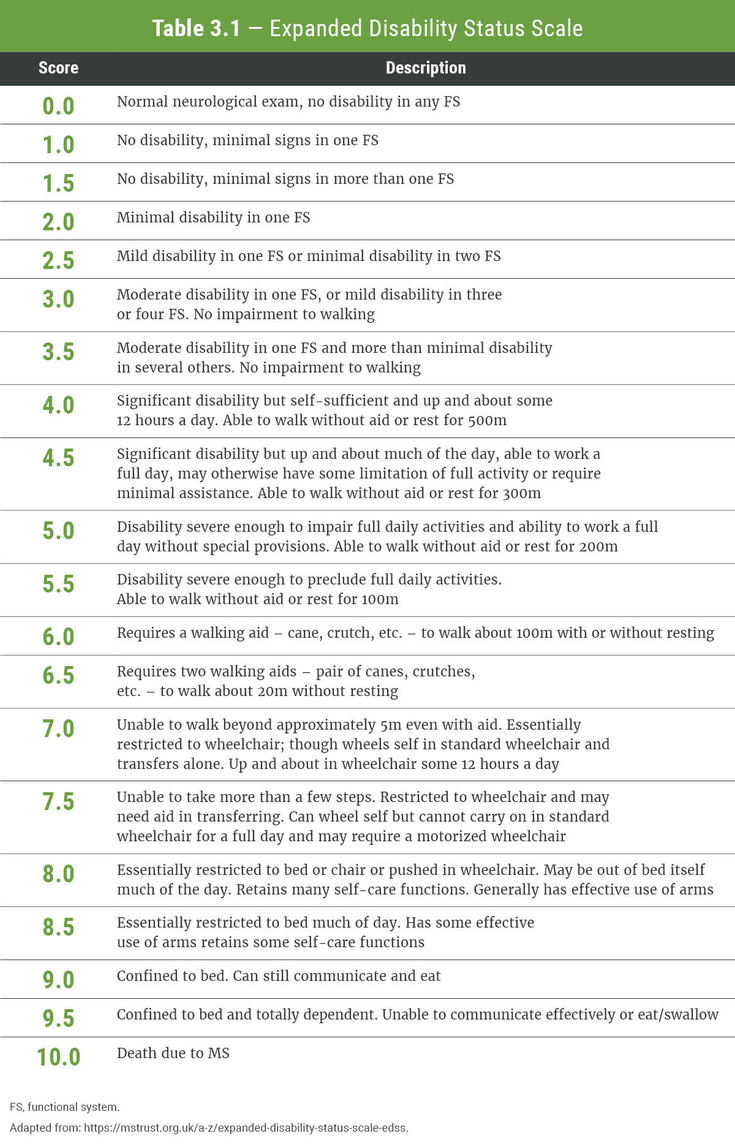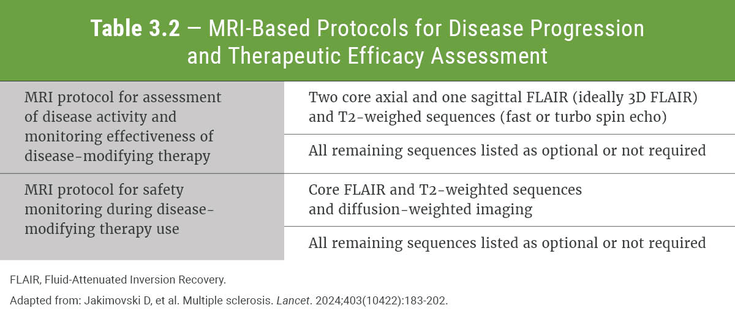Assessment of Multiple Sclerosis
Disease Severity and Progression
Once multiple sclerosis (MS) is diagnosed (see presentation), periodic assessment of disease severity is important both for tracking disease progression (and establishing prognosis) and for monitoring the efficacy of the chosen therapy. Widely used clinical assessment tools include the Expanded Disability Status Scale (EDSS) (to monitor the degree of disability), Magnetic resonance imaging (MRI) imaging (to assess lesion burden and tissue-specific injury), and patient-reported outcome (PRO) measures (to assess the patient’s health-related quality of life [HRQoL]).
The EDSS is an instrument developed to quantify the level of disability in patients with MS. First proposed by John Kurtzke in 1983, it has since been widely adopted and is the most commonly used method of quantifying MS-related disability in clinical trials. Scores on the EDSS are assigned based on a neurological exam and range from 0.0 to 10.0 in increments of 0.5, with higher scores…
To continue reading
Log in or register to continue reading. It's free!
OR
By signing up to create an account, I accept Healio's Terms of Use and Privacy Policy.
Disease Severity and Progression
Once multiple sclerosis (MS) is diagnosed (see presentation), periodic assessment of disease severity is important both for tracking disease progression (and establishing prognosis) and for monitoring the efficacy of the chosen therapy. Widely used clinical assessment tools include the Expanded Disability Status Scale (EDSS) (to monitor the degree of disability), Magnetic resonance imaging (MRI) imaging (to assess lesion burden and tissue-specific injury), and patient-reported outcome (PRO) measures (to assess the patient’s health-related quality of life [HRQoL]).
The EDSS is an instrument developed to quantify the level of disability in patients with MS. First proposed by John Kurtzke in 1983, it has since been widely adopted and is the most commonly used method of quantifying MS-related disability in clinical trials. Scores on the EDSS are assigned based on a neurological exam and range from 0.0 to 10.0 in increments of 0.5, with higher scores indicating greater degrees of disability (and with 10.0 representing death). The lower end of the scale (1.0 to 3.5) signifies no walking impairment but some disability in one or more of 8 functional systems (FS): pyramidal, cerebellar, brainstem, sensory, bowel and bladder function, visual function, cerebral function and “other”. Scores of 4.0 and higher signify a progressive impairment in mobility. The EDSS is presented in Table 3-1.
Another critical tool for monitoring the progression of MS is MRI. Classic MRI measures include T1 (“black hole”) and T2 (“hyperintense”) lesion number and volume (see Figure 2-1 in presentation for how these lesions appear on radiographs); however, these measures are of limited predictive value for disease progression. Several newer MRI-based techniques have been developed that improve the prognostic value of MRI. The introduction of double inversion recovery and phase-sensitive inversion recovery MRI sequences and the 7 Tesla MRI scanners (which provide higher resolution and better contrast than earlier scanners) markedly improved detection of cortical lesions. Susceptibility-based MRI sequences (e.g., phase-imaging, susceptibility-weighted imaging and quantitative susceptibility mapping) can detect paramagnetic rim lesions, which correspond to chronic active MS lesions; chronic active lesions can also potentially be detected as slowly expanding lesions by serial MRI using conventional T2-weighted and T1-weighted sequences. Another way to improve vision visibility is through Fluid-Attenuated Inversion Recovery (FLAIR), an MRI sequence that specifically suppresses the signal from cerebrospinal fluid (CSF). Consensus MRI protocols for MS progression and therapeutic efficacy monitoring are shown in Table 3-2.

Leptomeningeal inflammation is another potentially useful MRI marker. Associated with cortical atrophy, progressive disease and worse outcomes, it is best detected with high-resolution postcontrast T2 FLAIR MRI with delayed image acquisition. Another promising MRI marker is atrophied T2 lesion volume, which quantifies the amount of MS lesions replaced by CSF as a consequence of atrophy or destruction. It has been demonstrated to be a superior predictor of disability progression (as measured by an increase in the EDSS score) and conversion from clinically isolated syndrome (CIS), or relapsing-remitting MS (RRMS) to secondary progressive MS (SPMS) than T2 lesion volume.
Patient-reported outcome measures are instruments, typically questionnaires, intended for patient use for the purpose of gathering clinically relevant information on disease activity and/or intervention efficacy from the patient’s perspective. Given the heterogeneity of MS symptoms and lack of universally applicable “objective” assessment measures, effective management still relies on well-designed PRO measures. Many PRO measures are available for patients with MS (see Table 3-3), including both general instruments (i.e., those applicable to any disease; e.g., EQ-5D) and MS-specific instruments (e.g., MSIS-29, MSQoL-54). Instruments may measure overall health and quality of life, or be targeted to specific symptom clusters (e.g., multiple sclerosis neuropsychological questionnaire (MSNQ) is an instrument for cognitive assessment).
To be useful for HRQoL assessment, a PRO instrument must be validated (i.e., evaluated for accuracy and reliability), available in the patient’s language and practical for use (e.g., not be too time-consuming to complete). Irrelevant questions, scoring and analysis challenges and missing responses may limit the usefulness of some PRO measures. Although convenient, short-form instruments may lose important information. Furthermore, PRO instruments that assess function may fail to account for adaptations in patients with severe disability, providing an inaccurate picture.
In recent years, several serum and CSF biomarkers have been investigated with the intention of improving diagnostic and prognostic accuracy. The most prominent of these is the serum neurofilament light chain (NF-L), although other biomarkers, including glial fibrillary acidic protein (GFAP), chitinase-3-like 1-protein (CHI3L1) and Epstein–Barr virus (EBV) infection-related markers, are being investigated as potential biomarkers of clinical relevance. Neurofilaments are components of the cytoskeleton specific to neurons; when neuronal tissues in the CNS are damaged (e.g., when inflammatory MS lesions form), neurofilament components, including NF-L, are released into the CSF and the blood. A significant body of evidence now supports NF-L quantification as an inexpensive, non-invasive and safe modality for assessing inflammatory MS disease activity . A meta-analysis of 28 studies found that NF-L levels were significantly elevated in patients with MS (vs age-matched controls and CIS patients) and in patients in relapse (vs patients in remission). Furthermore, patients with high NF-L levels reached an EDSS score of 4 or higher significantly faster than those with low NF-L levels. Thus, serum NF-L quantification is likely to be widely adopted as a measure of disease activity. Nevertheless, this biomarker is meant to be complementary to and not a replacement for MRI, which will still be necessary to obtain information on lesion stages and distribution.
References
- D'Amico E, Haase R, Ziemssen T. Review: Patient-reported outcomes in multiple sclerosis care. Mult Scler Relat Disord. 2019;33:61-66.
- Freedman MS, Gnanapavan S, Booth RA, et al. Guidance for use of neurofilament light chain as a cerebrospinal fluid and blood biomarker in multiple sclerosis management. EBioMedicine. 2024;101:104970.






